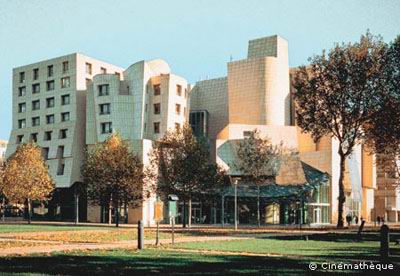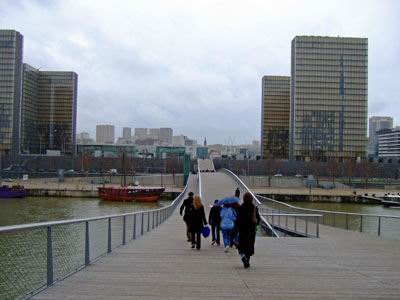Today we walked from the Hôtel de Ville to the east all the way to the edge of Paris to see how the city developed and grew throughout the centuries. Here were some of the places we passed:
1. Hôtel de Ville: not actually a hotel at all, this building is home of the Parisian government. The location has hosted the government of the city of Paris, since the 1300’s. However, the building we see today was constructed in the late 1800s after a fire in 1871 burned the previous building to the ground.
2. Église St. Gervais: the oldest church on the right bank of the Seine, this building has quite a long history. Construction for this church began in 1494, but as houses had to be demolished and work is always costly, the building was not completed until 1616. It is interesting to note the changes in architectural style throughout this gothic church. The highlight of the church may be the little carvings under the seats on the altar. Depicting both religious and secular scenes from daily life, some of the carvings are actually quite crude. For this reason, some of the more secular scenes were scratched down (but not destroyed) by religious people over the years.
3. Hôtel de Beauvais: This hotel was built by Antoine LePautre in the 1650’s for Catherine de Beauvais, the first chambermaid of King Louis XIV. Built in a small space not completely rectangular, trompe l’oeil paintings on the walls (no longer present) were used to give the building a grand appearance from the courtyard. Useless tidbit of information: Catherine de Beauvais was the first in a line of many mistresses of Louis XIV, moreover as a favor for his mother who was worrying that Louis XIV wasn’t expressing enough interest in women.
4. Église Saint-Paul-Saint-Louis: This Jesuit (Catholic) church was built in the 1630’s, during the Protestant Reformation. The paintings throughout this church are designed to affirm the dogma attacked by the Protestants. The very visual representations of biblical stories were designed to be clear and comprehensible, keeping with the Jesuit tradition of teaching.
5. Hôtel de Sully: This building was built by Jean Androuet Du Cerceau in 1625 and then owned by Sully, a man who worked for Henri IV. The building is ornate, with statues representing earth, wind, water, and fire facing the first courtyard paved in cobblestone. Statues representing two of the seasons also face this courtyard. The second courtyard in which the statues of the other two seasons are found faces an “orangerie,” a building in which orange trees were grown, something which became “très à la mode” after Louis XIV had one installed in Versailles. In the 1960’s, this neighborhood had fallen into disrepair when the state purchased the building for restoration. Today, this building is used by the minister of culture.
6. Place des Vosges: This square was known as the Place Royale before the Revolution, then called the Place d’Invisibilité until the First Empire. It was originally used for jousting amongst the nobles until the accidental death of Henri II during a tournament, at which point the queen Catherine de Medici had the area razed to be a public space. Henri IV finished this project, which turned out to be a failure: the nobles quickly moved into the buildings even though the king had intended for them to be used as shops. The red brick and white stone architecture seen in the Place des Vosges was very trendy during the early 1600’s when Henri IV was king.
7. Place de la Bastille: The place where the Bastille once stood is now a square at the meeting of the 4th, 11th, and 12th arrondissements. In the center of the square we see the Colonne de Juillet, constructed to commemorate the 1830 Revolution, when King Charles X was chased from Paris. Today, this area is a trendy and somewhat expensive area in Paris.
8. Rue Saint Antoine: Doors hidden between stores along this street open into little courtyards with several buildings. Inside these courtyards, the buildings have been protected with little modifications for centuries. Although not very ornate, the small details in the architecture can still be found, down to the fancy railings on the side stairwells.
9. L’Opéra de la Bastille: After lunch at the Barrio Latino, we continued with our walk around the 12ème arrondissement towards Bercy. The landmark building at the Place de la Bastille is the Opéra de la Bastille, the modern opera house of Paris. This building was built under the guide of former president Mitterrand as a place where the masses could come to enjoy classical music. It was created with over 2,700 seats, each having an unrestricted view of the stage. This opera house was built with the intention of replacing the Palais Garnier as the home base of the Opéra National de Paris. However, the Opéra de la Bastille was built with shoddy material and was poorly constructed so since its inauguration in 1989, it has been facing endless restoration.
10. Promenade Plantée/ Viaduc des Arts: A few minutes away from the Opéra de la Bastille, we climbed a set of stairs and found ourselves on top of the roof of the building we had just been standing in front of. It was not what we were expecting. Instead of a long row of gray roof, there was a pleasant brick pathway that stretched through rows and rows of garden as far as what we could see. This section of rooftop we were standing on was the end of what is known as the Promenade Plantée, a 4.5 km long park located on the roof of a series of connected buildings. It was once a railway in the 19th century, used to connect the Bastille and the eastern suburbs. This park is “one-of-a-kind” since it is currently the only “elevated” park in the world. From here pedestrians can appreciate the different architectural styles of the buildings across the street. The buildings on top of which the Promenade Plantée is located is known as the Viaduc des Arts, home of the skilled artisans of Paris. Here you’ll find arts and crafts workshops and studios which produce a number of unique items, including musical instruments, custom furniture, ceramics, glassware, and many objects which cannot be brought into the United States.
11. Gare de Lyon: From the Viaduc des Arts, we walked towards the Gare de Lyon, one of the six large railway terminus in Paris. This station was named after city of Lyon, a destination of many of the trains departing from here. The Gare de Lyon was built for the World Exposition of 1900, and it is most known for the large clock tower on the exterior of the building.
12. Quartier de Bercy et Parc de Bercy: A few minutes later we found ourselves in Bercy, one of the newer sections of Paris. This quartier was named after the Ministry of Finances, whose administrative building was moved here by Mitterrand from the Palais du Louvre in the 1980s. This area is known for its geometrical architecture, typical of buildings created during Mitterrand’s time. Bercy was once an open market and modernization of this area did not begin until 1960s/1970s. Unlike the other quartiers, Bercy’s boundaries are defined by barriers such as the métro and the périphérique.
A notable feature in this quartier is the Parc de Bercy, a 14 hectare park composed of 3 sections. The first segment of the park houses Paris’ POPB, the Palais Omnisports de Paris-Bercy, a large atheltic center and concert hall. This first part of the park is also known as “les Prairies” because of its large spaces of grass. During the summer, “les Prairies” is full of people playing soccer, having picnics, etc. From here, we spotted the Cinémathèque Française, the Museum of Cinema of Paris. This building was once the American Cultural Center of Paris. We called it Stata in Paris--it was designed by Frank Gehry (maybe as practice for Stata?).

The second section of the park is known as “les Parterres,” a garden dedicated to activities involving plants. Here we saw a vineyard, a vegetable garden, and a greenhouse. There is also a labryinth of shrubs for kids, a rose garden, and a long canal, which would be the perfect place for a summer wedding (or so said the server at La Coupole). The third section of the park is known as the “jardin romantique,” a part of the park with live fish and ducks swimming in the little ponds that dot this area. The landscaping here was beautiful even during the winter. Next door one can find Bercy Village, a shopping center and cinema where some of us had already explored the evening before to watch some movies.
13. Bibliothèque Nationale - François Mitterand: Parc de Bercy, we crossed the Simone-de-Beauvoir footbridge, the newest bridge in Paris, and walked over to the National Library of France.

In 1988 Mitterrand announced the contruction of this library, one of the largest and most modern libraries in the world. Supposedly this library houses books and material that cover all fields of knowledge. It is made up of a large espalande and four L-shaped towers at the corners of the complex. One of the towers had a huge pink X on it to signify that there is currently a temporary exhibit of pornographic and erotic materials housed in this tower. I guess this library really does house material of all fields of knowledge. (-Emilienne and Carmel)
